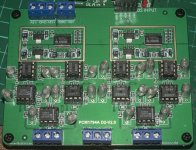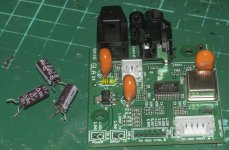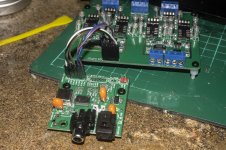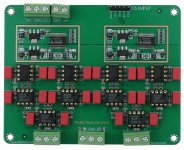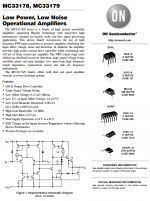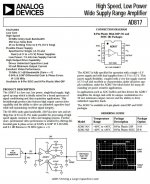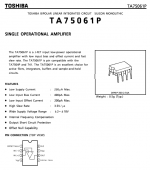Thanks for the info on op amps, very useful.
I was thinking I'd try it with the opamps I already have in my stash and then upgrade to more modern ones later, so I can hear the difference for myself.
I have HA5222, MC1458N, LM883N and NJM2904, I know they are all authentic as they are pulls from amplifiers I dismantled for parts. The comments I have found on them suggest the HA5222 sounds very good, the MC1458N is a dual 741 and very noisy, the LM883N performs like the NE5532 and I found no info on the NJM2904.
I was thinking I'd try it with the opamps I already have in my stash and then upgrade to more modern ones later, so I can hear the difference for myself.
I have HA5222, MC1458N, LM883N and NJM2904, I know they are all authentic as they are pulls from amplifiers I dismantled for parts. The comments I have found on them suggest the HA5222 sounds very good, the MC1458N is a dual 741 and very noisy, the LM883N performs like the NE5532 and I found no info on the NJM2904.
Just to get it up and running I fitted the opamps I had to hand - HA5222s, of which I had 7, plus three NE5332s to fill the remainder. The caps I used are Evox polystyrene.
I'm using a WM8805 receiver board, I changed the three 47uF electrolytics for Phillips 47uF tantalums, just to make sure I have no fake caps.
I'm using a WM8805 receiver board, I changed the three 47uF electrolytics for Phillips 47uF tantalums, just to make sure I have no fake caps.
Attachments
Please be careful. Since I made my own board I don't have your layout or schematic. However it looks like you might have mixed up some dual and single op-amps. At least the picture I have shows singles (NE5534) in some spots where you have duals (NE5532).
Again I don't have your layout (since I made my own design) so hopefully my advice is not incorrect. Please double check before you power it up.
I think you should have four duals installed and six singles.
Again I don't have your layout (since I made my own design) so hopefully my advice is not incorrect. Please double check before you power it up.
I think you should have four duals installed and six singles.
Attachments
Last edited:
Perhaps others with more experience will chime in. My favorite op amps are:
I would not use the OPA134 here. The OPA2134 seems to shine for the CS4398 filter. However the others are more suitable types for PCM1794.
- OPA228 (single) & OPA2228 (dual)
- LM4562 (dual)
- OPA1611 (single) & OPA1612 (dual)
- OPA134 (single), OPA2134 (dual), OPA4134 (quad).
I would not use the OPA134 here. The OPA2134 seems to shine for the CS4398 filter. However the others are more suitable types for PCM1794.
Thanks for the info.
The issue of fake opamps is always a concern.
I can buy OPA604 and OPA2604 cheap locally, with a fair degree of confidence they aren't fakes.
I can buy some older types NOS and be sure they aren't fakes, such as OP177, but my knowledge of opamps is very limited so I don't know what types I should be looking at.
It might be simplest to just buy some NE5534s and one more NE5532 (I already have 3, pulled from an Arcam Nicam decoder).
Maybe someone who has experience of this particular dual PCM1794 board can chime in with some details of what opamps they have used.
The issue of fake opamps is always a concern.
I can buy OPA604 and OPA2604 cheap locally, with a fair degree of confidence they aren't fakes.
I can buy some older types NOS and be sure they aren't fakes, such as OP177, but my knowledge of opamps is very limited so I don't know what types I should be looking at.
It might be simplest to just buy some NE5534s and one more NE5532 (I already have 3, pulled from an Arcam Nicam decoder).
Maybe someone who has experience of this particular dual PCM1794 board can chime in with some details of what opamps they have used.
Checking what my local store has for sale, which I am certain are genuine, I see a few types that might fit the bill:
MC33178 dual which onsemi describes as "Provides quality audio and data signal processing for applications"
Products - ON Semiconductor
They also have AD817 single type which might be suited. Other singles they have in stock are the older OP07 and Toshiba TA75061P
MC33178 dual which onsemi describes as "Provides quality audio and data signal processing for applications"
Products - ON Semiconductor
They also have AD817 single type which might be suited. Other singles they have in stock are the older OP07 and Toshiba TA75061P
Attachments
I would caution about the AD817 being a video amplifier. Such amplifiers often have considerably lower gain than a modern low distortion audio op-amp and higher distortion.
I would also caution about the TA75061 being low power, low gain and rather slow compared with any modern low distortion audio op-amp.
I think the classic NE5534 would be a better economy starting choice.
I would also caution about the TA75061 being low power, low gain and rather slow compared with any modern low distortion audio op-amp.
I think the classic NE5534 would be a better economy starting choice.
I can buy OPA604 and OPA2604 cheap locally, with a fair degree of confidence they aren't fakes.
If those are cheap and if they are not fake they might be a nice starting point. They are older but they are/were a real pro audio oriented offering.
If they are fake they might just be TL071/72 or TL081/82. The ruder fakes can be just LM358 or 4558 types. (Not even FET.)
Same reason I like DA102 transformer: it measures well, works well, and costs €1.33 on mouser.
Like you I use this Murata DA102 exclusively but it must be said that the pins are extremely fragile compared to for example the Pulse versions. Bending the pins is best avoided.
Ian,
thank you for shots
would you please point out shop where you bought pcm1794A D2 V2 pcb
could you please clarify If each dac chip work In parallel or not (each dual opamp gets two phases coming out from pcm1794A)
kozard,
could you show us your pcb
thank you for shots
would you please point out shop where you bought pcm1794A D2 V2 pcb
could you please clarify If each dac chip work In parallel or not (each dual opamp gets two phases coming out from pcm1794A)
Just to get it up and running I fitted the opamps I had to hand - HA5222s, of which I had 7, plus three NE5332s to fill the remainder. The caps I used are Evox polystyrene.
I'm using a WM8805 receiver board, I changed the three 47uF electrolytics for Phillips 47uF tantalums, just to make sure I have no fake caps.
kozard,
could you show us your pcb
Please be careful. Since I made my own board I don't have your layout or schematic. However it looks like you might have mixed up some dual and single op-amps. At least the picture I have shows singles (NE5534) in some spots where you have duals (NE5532).
Again I don't have your layout (since I made my own design) so hopefully my advice is not incorrect. Please double check before you power it up.
Last edited:
The Philips tantalum caps are not tantalum caps. You could call them fake tantalum caps but they’re the very good solid aluminium caps  SAL-RP122 I think, or the SAL-RPM128. These are 20.000 hours lifetime at 125 degrees Celsius and they were too expensive and thus they were discontinued.
SAL-RP122 I think, or the SAL-RPM128. These are 20.000 hours lifetime at 125 degrees Celsius and they were too expensive and thus they were discontinued.
Excellent in audio but they have brittle lead wires and one should not attempt to bend the pins close to the cap body as then the dipped epoxy "opens" just like has been done to the one near the terribly bad AMS1117 regulator (why the bad regulator is used in abundance is strange as it is worse than many other 3.3V regulator ICs). One other specific feature is that these tolerate a substantial reverse voltage. Both DC and AC that is!
Used after a regulator one has to take care that the regulator tolerates ultra low ESR caps at its output so in general this often means a low value should be used. On the board I would use 10 µF 16V and a better regulator to have the WM8805 perform optimally. In any case one should measure and check if the regulator doesn't oscillate. It would also be a good step to give the XO its own separate regulator. The unpopulated third input could be used for a nice 75 Ohm BNC connector.
Excellent in audio but they have brittle lead wires and one should not attempt to bend the pins close to the cap body as then the dipped epoxy "opens" just like has been done to the one near the terribly bad AMS1117 regulator (why the bad regulator is used in abundance is strange as it is worse than many other 3.3V regulator ICs). One other specific feature is that these tolerate a substantial reverse voltage. Both DC and AC that is!
Used after a regulator one has to take care that the regulator tolerates ultra low ESR caps at its output so in general this often means a low value should be used. On the board I would use 10 µF 16V and a better regulator to have the WM8805 perform optimally. In any case one should measure and check if the regulator doesn't oscillate. It would also be a good step to give the XO its own separate regulator. The unpopulated third input could be used for a nice 75 Ohm BNC connector.
Last edited:
This is where I bought the board:
Y3 Decoder Board Hifi DAC Parallel Dual PCM1794A 24Bit 192KHz Semi-Finished sz8 | eBay
Y3 Decoder Board Hifi DAC Parallel Dual PCM1794A 24Bit 192KHz Semi-Finished sz8 | eBay
My post was about the receiver board you use. If you confuse single and dual opamps and use solid aluminium caps instead of tantalum caps maybe it is a good tip to first determine what to use (or what one actually has) before the soldering/placing.
Regarding the small chance to find fake OPA2604: fake OPA2604 are often used in cheap/Chinese devices just like they are sold by Ebay sellers. The reason is simple: OPA2604 is out of production for a long time so rebranding any old dual opamp is then interesting for the guild of counterfeit producers. If one wants almost 100% guarantee then one must not buy any parts on Ebay. Last week I removed fake SMD OPA2604 to replace them for OPA1642 from a reputable distributor. In DIP OPA2134 is a good candidate amongst many others. The "good price" flag is therefor, as usual, often a red flag.
If one wants both "good price" and "very good quality" then OPA1656 on convertor boards may be an alternative.
OPA2604 is dead
Regarding the small chance to find fake OPA2604: fake OPA2604 are often used in cheap/Chinese devices just like they are sold by Ebay sellers. The reason is simple: OPA2604 is out of production for a long time so rebranding any old dual opamp is then interesting for the guild of counterfeit producers. If one wants almost 100% guarantee then one must not buy any parts on Ebay. Last week I removed fake SMD OPA2604 to replace them for OPA1642 from a reputable distributor. In DIP OPA2134 is a good candidate amongst many others. The "good price" flag is therefor, as usual, often a red flag.
If one wants both "good price" and "very good quality" then OPA1656 on convertor boards may be an alternative.
OPA2604 is dead
Last edited:
Hi all,
Good timing on this thread, I was about to post a question on this very board.
I've noticed a high current draw even at idle, 12v = 310mA.
According to the specs. the NE5532 should be max 16mA, and the NE5534 10mA. This makes 114mA.
The PCM1794A gets it's 3.3V from the 5V rail and according to the datasheet the 5V line is almost nothing.
When I stick the multimeter with a heat detector on it the PCM1794's are warm, the 4x NE5532 are the warmest and the NE5534 are fairly cold.
Any ideas? I ideally need better efficiency than this as I'm boosting 5v USB up to the 12v rail and that's circa 1A or more from the USB line.
Good timing on this thread, I was about to post a question on this very board.
I've noticed a high current draw even at idle, 12v = 310mA.
According to the specs. the NE5532 should be max 16mA, and the NE5534 10mA. This makes 114mA.
The PCM1794A gets it's 3.3V from the 5V rail and according to the datasheet the 5V line is almost nothing.
When I stick the multimeter with a heat detector on it the PCM1794's are warm, the 4x NE5532 are the warmest and the NE5534 are fairly cold.
Any ideas? I ideally need better efficiency than this as I'm boosting 5v USB up to the 12v rail and that's circa 1A or more from the USB line.
- Home
- Source & Line
- Digital Line Level
- Ebay parallel PCM1794 DAC any good
